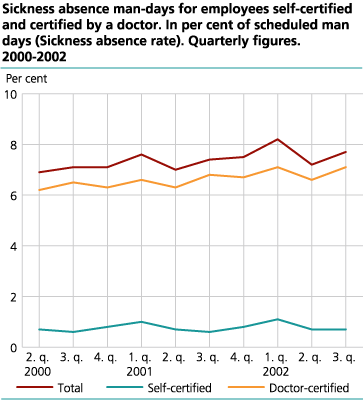Content
Published:
This is an archived release.
Sickness absence up to 7.7 per cent
The total sickness absence increased from 7.4 per cent in the third quarter of 2001 to 7.7 per cent in the third quarter of 2002. The increase is mainly due to an increase in doctor-certified absence . The new figures of self-certified sickness absence in the third quarter of 2002 were at about the same level in the corresponding period the year before.
This statistics cover all employees 16-69 years of age. Measured in per cent of scheduled man-days, the self-certified sickness absence was 0.7 per cent in the third quarter of 2002.
The total sickness absence rate increased from 7.4 per cent in the third quarter of 2001 to 7.7 per cent in the third quarter of 2002. The annual increase of 0.3 percentage points corresponds to an annual growth of 3.8 per cent.
From doctor-certified to self-certified sickness absence
Many enterprises have opened for a change in the maximum period of self-certified sickness absence lately, from 3 to 8 consecutive calendar days. A transfer of sickness absence from doctor-certified to self-certified sickness absence is the result. Changes in the doctor-certified sickness absence from 4-8 days last year indicate such a transfer. For the time being the effects are small in the self- and doctor-certified sickness absences rates.
In the third quarter of 2002 11 out of 12 lost man-days due to sickness absence were doctor-certified absences.
The self-certified sickness absence varies less between different industries and sexes than the sickness absence certified by a doctor.
Health and social work had the highest self-certified sickness absence
The self-certified sickness absence varies less between industries than the sickness absence certified by a doctor. The section health and social work had the highest self-certified sickness absence, with an absence rate of 0.8 per cent in the third quarter of 2002.
Women have higher sickness absence
Compared with men, women have higher total sickness absence, 9.3 versus 6.5 per cent. Of this 2.8 percentage point difference, 2.6 percentage points is gender difference from doctor-certified sickness absence. Sickness absence regarding pregnancy may explain some of the differences in sickness absence.
Doctor-certified sickness absences statistics with more details are also published on our web site: http://www.ssb.no/sykefra_en/ .
The sickness absence statistics are produced in cooperation with the National Insurance Administration (RTV).
Tables:
- Table 1 Sickness absence man-days for employees self-certified and certified by a doctor. In per cent of scheduled man-days (Sickness absence rate). Quarterly figures. 2000-2002
- Table 2 Sickness absence man-days for employees self-certified and certified by a doctor, by sex. In per cent of scheduled man-days (Sickness absence rate). Quarterly figures. 2000-2002
- Table 3 Sickness absence man-days for employees self-certified and certified by a doctor, by industry and type of sickness absence. In per cent of scheduled man days (Sickness absence rate). Quarterly figures. 2000-2002
Contact
-
Arbeidsmarked og lønn
E-mail: arbeidsmarked@ssb.no
-
Unn H. Høydahl
E-mail: unnh.hoydahl@ssb.no
tel.: (+47) 40 90 23 77

